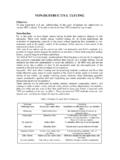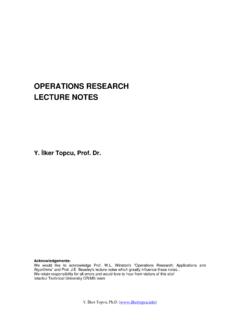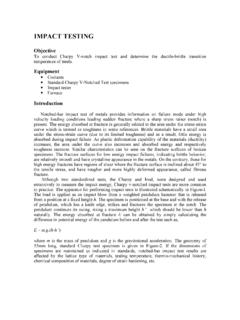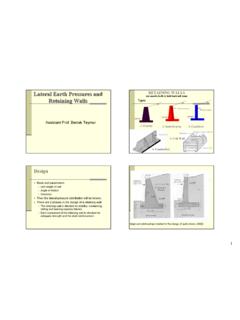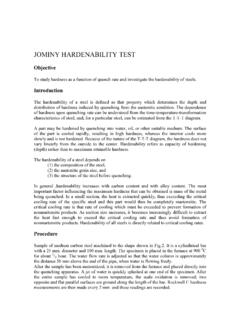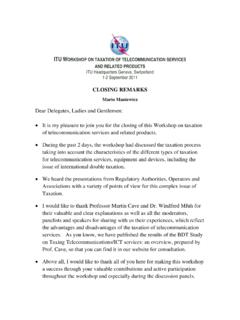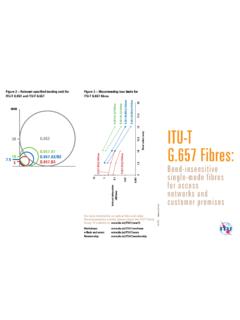Transcription of Chapter 4 Open Channel Flows - İTÜ
1 Prof. Dr. At l BULU 1 Chapter 4 open Channel Flows Introduction When the surface of flow is open to atmosphere, in other terms when there is only atmospheric pressure on the surface, the flow is named as open Channel flow. The governing force for the open Channel flow is the gravitational force component along the Channel slope. Water flow in rivers and streams are obvious examples of open Channel flow in natural channels. Other occurrences of open Channel flow are flow in irrigation canals, sewer systems that flow partially full, storm drains, and street gutters.
2 Classification of open Channel Flows A Channel in which the cross-sectional shape and size and also the bottom slope are constant is termed as a prismatic Channel . Most of the man made (artificial) channels are prismatic channels over long stretches. The rectangle, trapezoid, triangle and circle are some of the commonly used shapes in made channels. All natural channels generally have varying cross-sections and consequently are non-prismatic. a) Steady and Unsteady open Channel Flow: If the flow depth or discharge at a cross-section of an open Channel flow is not changing with time, then the flow is steady flow, otherwise it is called as unsteady flow.
3 Flood Flows in rivers and rapidly varying surges in canals are some examples of unsteady Flows . Unsteady Flows are considerably more difficult to analyze than steady Flows . b) Uniform and Non-Uniform open Channel Flow: If the flow depth along the Channel is not changing at every cross-section for a taken time, then the flow is uniform flow. If the flow depth changes at every cross-section along the flow direction for a taken time, then it is non-uniform flow. A prismatic Channel carrying a certain discharge with a constant velocity is an example of uniform flow.
4 C) Uniform Steady Flow: The flow depth does not change with time at every cross section and at the same time is constant along the flow direction. The depth of flow will be constant along the Channel length and hence the free surface will be parallel to the bed. (Figure ). Prof. Dr. At l BULU 2 Figure Mathematical definition of the Uniform Steady Flow is, 0,0021= = ==xytyyyy ( ) y0 = Normal depth d) Non-Uniform Steady Flows : The water depth changes along the Channel cross-sections but does not change with time at each every cross section with time. A typical example of this kind of flow is the backwater water surface profile at the upstream of a dam.
5 Figure Non-Uniform steady Flow Mathematical definition of the non-uniform steady flow is; 021 xyyy Non-Uniform Flow ( ) 0,021= = tyty Steady Flow y1=y0y2=y0 S0 x y y1 y2 x y Prof. Dr. At l BULU 3If the flow depth varies along the Channel , these kinds of Flows are called as varied Flows . If the depth variation is abrupt then the flow is called abrupt varied flow (flow under a sluice gate), or if the depth variation is gradual it is called gradually varied flow (flow at the upstream of a dam).
6 Varied Flows can be steady or unsteady. Flood Flows and waves are unsteady varied Flows since the water depths vary at every cross-section and also at each cross-section it changes with time. If the water depth in a flow varies at every cross-section along the Channel but does not vary with time at each cross-section, it is steady varied flow. Types of Flow The flow types are determined by relative magnitudes of the governing forces of the motion which are inertia, viscosity, and gravity forces. a) Viscosity Force Effect: Viscosity effect in a fluid flow is examined by Reynolds number.
7 As it was given in Chapter 1, Reynolds number was the ratio of the inertia force to the viscosity force. ityForceVisceInertiaForcosRe= For the pressured pipe Flows , 2000Re<= VD Laminar flow 2500Re>= VD Turbulent Flow Since D=4R, Reynolds number can be derived in open Channel Flows as, 500Re20004Re<= === VRRVVD Laminar Flow ( ) 625Re25004Re>= === VRRVVD Turbulent Flow ( ) 625Re500<< Transition zone Prof. Dr. At l BULU 4 R is the Hydraulic Radius of the open Channel flow cross-section which can be taken as the flow depth y for wide channels. Moody Charts can be used to find out the f friction coefficient by taking D=4R.
8 Universal head loss equation for open Channel Flows can be derived as, 222288242 VgRSfgRfVLhSLgVRfLgVDfhLL=== = = Since Friction Velocity is, gRSu== 0 228 Vuf = ( ) b) Gravity Force Effect: The ratio of inertia force to gravity force is Froude Number. LAgVFrceGravityForceInertiaForFr== ( ) Figure A=Area L y B Prof. Dr. At l BULU 5 Where , A = Wetted area L= Free surface width For rectangular channels, gyVBBygVFBLByAr==== ( ) =1Fr Critical Flow <1Fr Sub Critical ( ) >1Fr Super Critical Flow Energy Line Slope for Uniform open Channel Flows Figure Horizontal Datum z1 y V2/2g y yV2/2g hL Energy Line x L Free Water Surface=Hydraulic Grade Line z2 Prof.
9 Dr. At l BULU 6 The head (energy) loss between cross-sections 1 and 2, VVVypphgVpzgVpzL====+++=++21212222211122 21zzhL = The head loss for unit length of Channel length is energy line (hydraulic) slope, SinLzzLhSLener= ==21 Since in open Channel Flows the Channel slope is generally a small value, TanSin <00105 = =0 SxhTanL ( Channel bottom slope) 0 SSener= ( ) Conclusion: Hydraulic grade line coincides with water surface slope in every kind of open Channel Flows . Since the velocity will remain constant in every cross section at uniform Flows , energy line slope, hydraulic grade line slope (water surface slope) and Channel bottom slope are equal to each other and will be parallel as well.
10 EnerSSS==0 ( ) Where S is the water surface slope. Pressure Distribution The intensity of pressure for a liquid at its free surface is equal to that of the surrounding atmosphere. Since the atmospheric pressure is commonly taken as a reference and of equal to zero, the free surface of the liquid is thus a surface of zero pressure. The pressure distribution in an open Channel flow is governed by the acceleration of gravity g and other accelerations and is given by the Euler s equation as below: Prof. Dr. At l BULU 7 In any arbitrary direction s, ()saszp = + ( ) and in the direction normal to s direction, in the n direction, ()nazpn =+ ( ) in which p = pressure, as = acceleration component in the s direction, an = acceleration in the n direction and z = geometric elevation measured above a datum.
